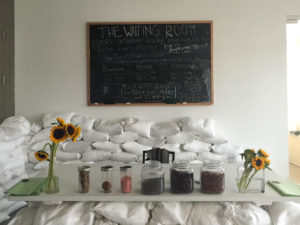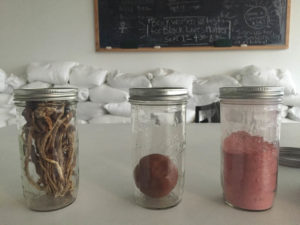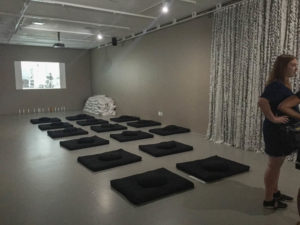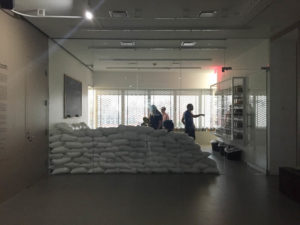In a gallery-cum-movement studio on the Fifth Floor of the New Museum, I sat amongst a circle of men and women gathered for a Thursday evening Afrocentering class. The session, led by dancer Aimee Meredith Cox, was part of Care Sessions—a three-month program led by holistic health practitioners as part of artist Simone Leigh’s latest installation, The Waiting Room.
Part of an ongoing exploration of female black subjectivities, Leigh’s installation exposes related injustices of the healthcare system while also shedding light on the transformative potential of holistic care. An introductory essay for The Waiting Room begins with the story of Esmin Green, a forty-nine-year-old woman and Jamaican native from Brooklyn who waited for nearly twenty-four hours to receive treatment after being admitted to the emergency room at Kings County Hospital Center. Green subsequently collapsed in the waiting room, still left unattended on the floor for over an hour as she died.
The heartbreaking reality of Esmin Green’s story serves as a stark introduction to the exhibition, also serving as a gateway for references to community-organized care as acts of resistance. Leigh references historical examples such as the United Order of Tents (a secret society of nurses active since the Underground Railroad) and health clinics run by the Black Panther Party from the 1960s to the 1980s, citing revolutionary efforts to battle indifference and address urgent needs of the black community. She highlights the ongoing struggle for women of color. Further, the exhibition ignites a larger conversation about the universality of experience and how each one of us, regardless of gender or race, responds to questions and about self and social care in the present.
The programming schedule for The Waiting Room defined Afrocentering as “a movement philosophy created by Aimee Meredith Cox that focuses on mind-body connection and self-awareness.” Not knowing what to expect, I showed up in yoga pants with an open mind, hoping to find some respite after a difficult day. Arriving in the gallery a few minutes early, I milled around the apothecary installed next door and read listings on a chalkboard for other care sessions: massage, acupuncture, herbalism, meditation. Moving into the gallery, I noticed a few video monitors—one showing documentary footage from Free People’s Medical Clinic, Leigh’s 2014 project (housed in the former Bedford-Stuyvesant, Brooklyn home of Dr. Josephine English, the first black OB-GYN in the state of New York).
How do you take care of yourself?
What do you care about?
Gathering participants together, Cox sat us down on the floor and posed these two questions to the group as a sort of introduction to the session. The simple yet direct nature of the questions caught me by surprise, matched by the earnest answers shared amongst strangers in our first ten minutes together. Admittedly, I’d been skeptical of how these classes would work in a gallery setting. In contrast to Free People’s Medical Clinic, situated in a historic location with public access for the Bed-Stuy community, I questioned whether the conceptual framework of holistic care sessions could provide meaningful experiences for museum visitors tucked away on one of its upper floors.
In a group numbering around twenty, there were men and women of various races and ages, locals from New York mixed in with tourists visiting from around the globe. The woman next to me shared that she took care of herself by swimming in the sea. Another man talked of long walks in the city to clear his mind. I spoke of remembering to breathe. Cox, a dancer and former member of the Alvin Ailey Repertory Ensemble—who is also a cultural anthropologist and tenured professor of African and African American Studies at Fordham University—talked more about her own role as a practitioner and advocate empowering young black women to take control of their bodies and their futures. In a gallery bordered by symbolic rows of white sandbags, she spoke of the revolutionary potential of self and community care.
During the hour that followed, there was movement. A lot of movement. As we danced, museum visitors continued to move through and watch our group from the sides of the gallery. At times, I lost the sequence of steps and had no idea what was happening. But I followed Cox’s advice, continuing to move and make it up until I could pick up the flow again. It is a simple metaphor. Ridiculously simple. But in the context of Leigh’s exhibition and the contrast of my own subjectivity as a white woman, it also felt symbolic of my own struggle to better understand the system of social inequities that I am also a part of.
In The Waiting Room, Simone Leigh creates a valuable space for contemplation. Paired with a unique opportunity to engage directly with practitioners, I experienced an environment earnestly geared towards wellness. Furthermore, the gallery setting grounds these care sessions in a history of holistic care rooted in urgency and conflict rather than luxury and comfort. Leigh educates us in her struggle for increased dialogue and justice, also presenting true alternatives and access in response. Building upon the questions posed by Aimee Meredith Cox about how we care for ourselves and the world around us, the exhibition ultimately translates as a call to action.
What are we waiting for?





